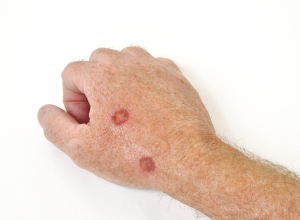Premalignant skin cancer comes in two common types.
1. The actinic keratosis (or solar keratosis) is a premalignant skin lesion, which can develop in sun exposed area, typically the face, lower lip, neck or the back of the hands or forearms.
Actinic keratoses often develop in groups in the sun damaged skin. The skin lesions are skin colored to yellow brown raised papules. The surface of them is rough and scaly. They are a few millimeters to 1 cm in diameter. In Australia about 40% of the population over 40 years of age has one or more such actinic keratosis.
About 20 to 25% of these pre malignant lesions will turn into carcinoma in situ (the very first step of skin cancer) and eventually into the invasive squamous cell cancer. The reason it is so important to recognize the actinic keratoses, is that we can prevent a disaster later by acting early and treating these initially harmless skin lesions with liquid nitrogen. One or two treatments often will remove actinic keratoses without a scar. Here is a link to a picture of actinic keratosis (thanks to library.med.utah.edu for this image) where the areas with lesions were circled. A closer look in another patient reveals the actinic keratosis lesions in more detail (thanks to www.nlm.nih.gov/medlineplus for this image).
There are many other pre malignant skin lesions, but it would be up to your treating physician or dermatologist to advice you further.
2. The other pre malignant lesion is found on mucous membranes and is called leukoplakia (thanks to hardinmd.lib.uiowa.edu for this image). This is a white patch on the mucous membrane of the oral cavity (in the link here shown on the tongue) and at the vulva (at the entrance to the vagina). Such lesions should be referred to a dermatologist as about 20% turn out on biopsy to show dysplasia (a precancerous condition ) and 15% of these will turn into carcinoma in situ (the first stage of a local skin cancer). 3% to 6% of the dysplasia develop into invasive squamous cell carcinoma. There are various ways of how the dermatologist can treat these lesions successfully.
References:
1. Kripke ML, Sass ER,eds.”Antigenicity of murine skin tumors induced by UV light”.JNCI 1974;53:1333-1336.
2. Kripke ML. “Immunology and photocarcinogenenis”. J. Am. Acad.Dermatol. 1986;14:149-155.
3. Potter M.”Percivall Pott’s contribution to cancer research”. NCI Monogr.1963;10:1.
4. COMS Group: Collaborative ocular melanoma study manual of procedures. National Technical Information Service. Springfield,VA, 1989.
5. Cancer: Principles &Practice of Oncology. 4th edition. Edited by Vincent T. DeVita, Jr. et al. Lippincott, Philadelphia,PA, 1993. Chapter on Cancer of the skin.
6. Cancer: Principles&Practice of Oncology. 5th edition, volume 2. Edited by Vincent T. DeVita, Jr. et al. Lippincott-Raven Publ., Philadelphia,PA, 1997. Chapter on Cancer of the skin.
7. Conn’s Current Therapy 2004, 56th ed., Copyright © 2004 Elsevier
8. Ferri: Ferri’s Clinical Advisor: Instant Diagnosis and Treatment, 2004 ed., Copyright © 2004 Mosby, Inc.








